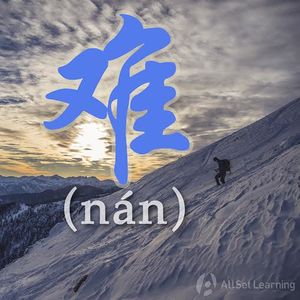Difference between revisions of "Expressing "difficult" with "nan""
m (Text replace - "{{Grammar Box}} " to "{{Grammar Box}} ") |
|||
| Line 3: | Line 3: | ||
Whenever something is "hard to do" (as in difficult) or "bad to do" (as in bad experience), the word 难 (nán) can be used. | Whenever something is "hard to do" (as in difficult) or "bad to do" (as in bad experience), the word 难 (nán) can be used. | ||
| − | == | + | == 难 with General Verbs == |
| + | |||
| + | === Structure === | ||
Just as 好 can be used to indicate that it's [[easy to do something]], 难 (nán) can be attached to verbs, except sensitive words, to indicate that something is ''hard to do''. The structure is: | Just as 好 can be used to indicate that it's [[easy to do something]], 难 (nán) can be attached to verbs, except sensitive words, to indicate that something is ''hard to do''. The structure is: | ||
| Line 13: | Line 15: | ||
</div> | </div> | ||
| − | == Examples == | + | === Examples === |
<div class="liju"> | <div class="liju"> | ||
| Line 28: | Line 30: | ||
*这 个 汉字 很 <em> 难 写</em>。<span class="trans">This character is very difficult to write.</span> | *这 个 汉字 很 <em> 难 写</em>。<span class="trans">This character is very difficult to write.</span> | ||
| + | </div> | ||
| − | + | == 难 with Sense Verbs == | |
| − | == Structure | + | === Structure === |
难 (nán) can also be attached to "sense verbs" (e.g. look, taste, smell, etc.) to indicate that something is ''bad to do''. The structure is: | 难 (nán) can also be attached to "sense verbs" (e.g. look, taste, smell, etc.) to indicate that something is ''bad to do''. The structure is: | ||
| Line 41: | Line 44: | ||
</div> | </div> | ||
| − | == Examples == | + | === Examples === |
<div class="liju"> | <div class="liju"> | ||
Revision as of 06:38, 21 February 2014
-
Level
-
Similar to
-
Used for
-
Keywords
Whenever something is "hard to do" (as in difficult) or "bad to do" (as in bad experience), the word 难 (nán) can be used.
Contents
难 with General Verbs
Structure
Just as 好 can be used to indicate that it's easy to do something, 难 (nán) can be attached to verbs, except sensitive words, to indicate that something is hard to do. The structure is:
Subject + (很) 难 + Verb
Examples
- 难 懂Hard to understand.
- 这 句 话 很 难 懂。This talk is hard to understand.
- 难 学Hard to learn.
- 汉语 很 难 学。Mandarin is hard to learn.
- 难 做Hard to do.
- 三明治 很 难 做。Sandwiches are hard to make.
- 难 买Hard to buy (as in probably hard to find).
- 这 个 东西 现在 很 难 买。This thing is really difficult to purchase now.
- 难 写Difficult to write.
- 这 个 汉字 很 难 写。This character is very difficult to write.
难 with Sense Verbs
Structure
难 (nán) can also be attached to "sense verbs" (e.g. look, taste, smell, etc.) to indicate that something is bad to do. The structure is:
Subject + (很) 难 + [Sense Verb]
Examples
- 难听Sounds bad(hard to listen to).
- 这 首 歌 很 难听。This song is terrible (This song is hard to listen to).
- 难闻Smells bad. (it stinks)
- 这 只 小 猫 很 难闻。This little cat smells bad.
- 难看Hard to look at (looks bad/ugly).
- 这 件 衣服 很 难看吗?Is this piece of clothing ugly?
- 难吃Disgusting (hard to eat).
- 你 做的菜 很 难吃。The dishes you cook taste bad.



